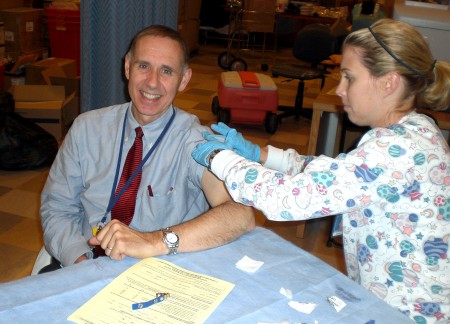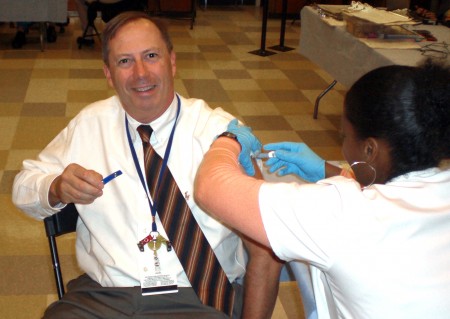
Our Chairman, Dr. J. Brooks Jackson, happily receives his vaccination.

Our administrator, Al Valentine, confidently receiving the flu shot.
This week’s blog posting is about the flu, and we were very fortunate to interview three of Hopkins’ leading experts, Dr. Alexandra Valsamakis (Director of Clinical Virology and Molecular Microbiology), Dr. Patricia Charache (Professor of Pathology, Medicine and Oncology), and Alicia Budd (Senior Infection Control Epidemiologist) about this topic:
What advice would you give to any employee or a nonemployee who is afraid of getting the flu shot?
Please do…it will help protect you, your family, your co-workers, and our patients. If you have enough guts to ride the bus or drive a car, you have more than enough courage to get the flu shot. And, if you’re afraid of shots and needles, there’s a nasal spray influenza vaccine that may be appropriate for you.
What is the traditional flu season? When does it generally start and end?
Influenza season typically runs from December to April, however, it can begin earlier and has been known to continue into May.
Do you think experts predict a longer flu season in 2010-11, or a more far-reaching flu season?
Not really.
What are the predominant respiratory viruses in the U.S.?
Influenza A, Influenza B, respiratory syncytial virus, parainfluenza virus types 1-4, adenoviruses, human metapneumovirus, rhinoviruses, and enteroviruses.
This year’s flu shot combines three types of influenzas. Can you tell us about this? Also, how do these influenzas get their names?
There are three types of flu in the vaccine every year, not just this year. Since there are two different influenza A types and influenza B strains that circulate every year, these viruses are in the vaccine. They include an influenza A H3/N2 virus, influenza A H1N1 virus, and one influenza B strain. The strains selected to be included in the vaccine are the predominant influenza viruses that were circulating in the southern hemisphere during their respiratory virus season, since these are the viruses that are most likely to be transmitted to the northern hemisphere. This year the three viruses are the swine flu from last year (so called “A/California/7/2009H1N1”), plus the other influenza A (A/Perth/16/2009 H3N2), plus influenza B (B/Brisbane/60/2008). Note that influenza strains are identified by sentinel labs throughout the world and are named by the type, the location they were first isolated, the virus’s numerical sequence of isolation, the year of isolation, and the type of hemagglutinin and neuraminidase (two proteins on the outer surface of the virus). So A/California/7/2009 H1N1 is influenza A isolated as the 7th influenza from California’s sentinel lab in 2009 with type 1 hemagglutinin and type 1 neuraminidase.
Does the flu shot contain the preservative, thimerosol? If so, can one get a shot without this preservative?
Influenza vaccines are available in trace thimerosol or thimerosol-free formulations. The vaccine supply this year is approximately half/half. There is no convincing evidence of harm from the small amount of thimerosal in the influenza vaccine. In fact, there is more mercury in a can of tuna than there is in the influenza vaccine.
Do older adults need a different kind of vaccination? There have been some TV commercials about this.
I’m unaware that older adults require vaccination with a different vaccine. The nasal vaccine, however, is not licensed for use in individuals over the age of 49.
What methodologies in the Microbiology Lab do you use to diagnose viral infections?
We use direct detection for viral antigens in nasopharyngeal swabs. Antigens are detected by immunofluorescently-labeled antibodies whose binding is visualized by med techs using a fluorescence microscope. The test is relatively rapid (~2 hrs), although our time to report is 4-6 hrs within receipt in the Lab. The test is performed 24/7/52. If DFA is negative, we look for viruses with more sensitive methods that depend on a person’s immune system function. If the host has a normal immune system, we test by rapid culture (so-called “shell vials” or “spin amplification culture”) that is resulted after 48 hours. If the host has a questionable immune system, we test by amplifying virus genome from nasopharyngeal swab (so called “polymerase chain reaction” or PCR).
Who makes up the immunocompromised population that really should be vaccinated against the flu?
Experts recommend that everyone over the age of 6 months receive influenza vaccine each year. While everyone should get a flu vaccine each flu season, it’s especially important that the following groups get vaccinated either because they are at high risk of having serious flu-related complications or because they live with or care for people at high risk for developing flu-related complications:
- Pregnant women
- Children younger than 5, but especially children younger than 2 years old
- People 50 years of age and older
- People of any age with certain chronic medical conditions
- People who live in nursing homes and other long-term care facilities
- People who live with or care for those at high risk for complications from flu, including:
Health care workers
Household contacts of persons at high risk for complications from the flu
Household contacts and out of home caregivers of children
Please tell us about concept of “herd immunity” and how it applies to the flu vaccine.
Herd immunity refers to the fact that if a very high percentage of a community is immune to a given disease, people who have no immunity are far less likely to be exposed to someone who has active disease. They are therefore protected by the immune “herd” that surrounds them. Influenza vaccine can provide some herd immunity, but for many reasons, this should be considered protective in the same way we can see herd immunity in some other vaccine-protected diseases.
Among these reasons are the following: 1) Influenza vaccine protection is relatively brief, lasting only months, rather than a lifetime. 2) For people whose immunity is waning, or young children and the over 55 and elderly populations, vaccine protection is less effective in preventing disease occurrence. The influenza vaccine is especially strongly urged for that group, however, because of resulting immunity, even when only partial, does provide protection against severe disease. As it reduces severity, it reduces risk of hospitalization and the risk of a fatal disease. 3) Finally, even mild disease results in the viral shedding that can spread the virus to others in the community who are unprotected.
Therefore, although some herd immunity may occur in populations heavily vaccinated for influenza viruses, the herd immunity protection should not be expected to parallel that seen in very different diseases, and different types of immunity.
Where can I go to get a flu shot?
Occupational Health offers the influenza vaccine to physicians, faculty, staff, employees, students, and volunteers . The dates and times that the vaccine will be administered are below.
| Location | Date | Time |
| Pediatric Annex | 9/28/10 – 10/1/10 & 10/4/10 – 10/6/10 |
6:30AM – 6:00PM |
| Pediatric Annex | 10/2/10 & 10/3/10 | 6:00AM – 10:00AM |
| Pediatric Annex | 10/9/10 | 6:00AM – 10:00AM |
| Houck Lobby | 9/28/10 – 10/1/10 & 10/4/10 – 10/8/10 |
7:00AM – 5:00PM |
| JHOC Plaza | 9/28/10 – 10/1/10 & 10/4/10 – 10/8/10 |
7:00AM – 5:00PM |
| Asthma/ Allergy Atrium | 9/28/10 – 10/1/10 | 7:00AM – 4:00PM |
AFTER OCTOBER 9, 2010 THE VACCINE WILL BE ADMINISTERED AT PHIPPS 351 AND 98 BROADWAY, SUITE 421, MONDAY THROUGH FRIDAY, 7:30 AM to 4:00 PM.
Do I have to pay for a flu shot?
The influenza vaccine is free for all physicians, faculty, staff, employees, students and volunteers .
Will there be enough flu shots for everyone?
Yes. At this time there are no problems with influenza vaccine production or distribution that are expected to result in shortages of vaccine.
Is this vaccine safe?
Yes. The safety profile of flu vaccine is very impressive. The most common reactions are local injection- site tenderness with the flu shot, or headache with the nasal spray vaccine.
Is there a priority list of people who should get a flu shot?
No. This year, because supplies are plentiful, there is no need to prioritize based on exposure or disease risk. Anyone interested in being vaccinated can go to one of the Occupational Health sites listed above.
What sort of flu season is expected this year?
Although epidemics of flu happen every year, the timing, severity, and length of the epidemic depends on many factors, including what influenza viruses are spreading and whether they match the viruses in the vaccine. Last flu season (2009-2010) a new flu virus emerged, the 2009 H1N1 influenza virus (previously called “novel H1N1” or “swine flu”). Because this was a new virus to which very few people worldwide had immunity, it caused the first influenza pandemic (global outbreak of disease caused by a new flu virus) in more than 40 years. While not certain, it is likely that 2009 H1N1 viruses will continue to spread along with seasonal viruses in the U.S. during the 2010-2011 flu season.
Again, our special thanks to Dr. Alexandra Valsamakis, Dr. Patricia Charache, and Ms. Alicia Budd for their contributions to this special Pathology Blog posting.